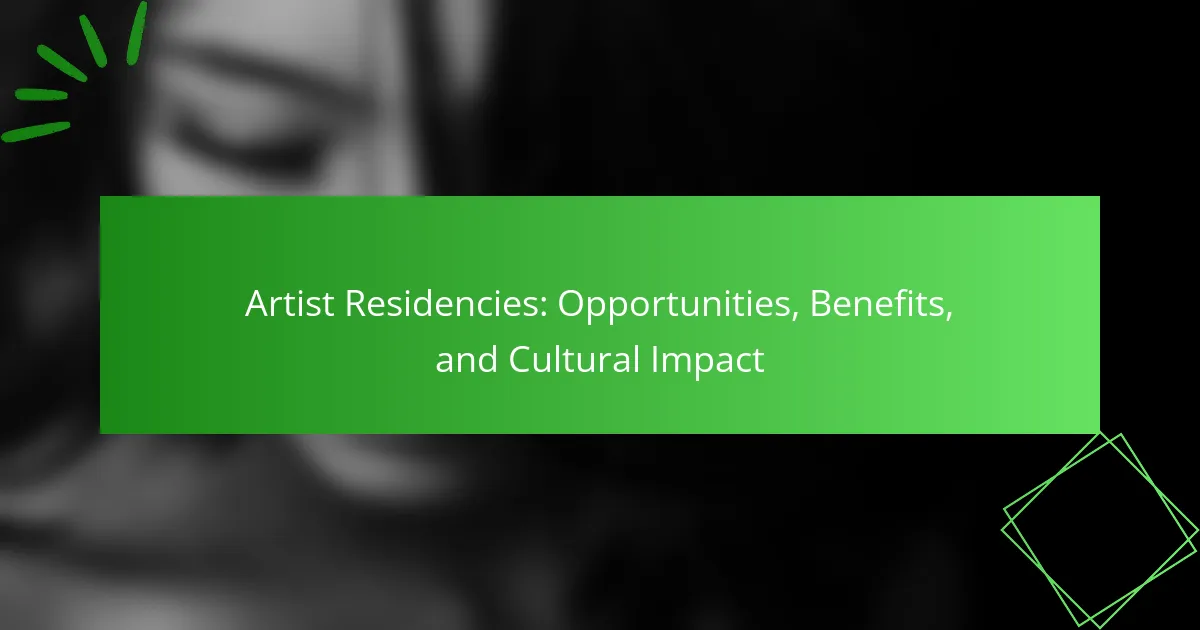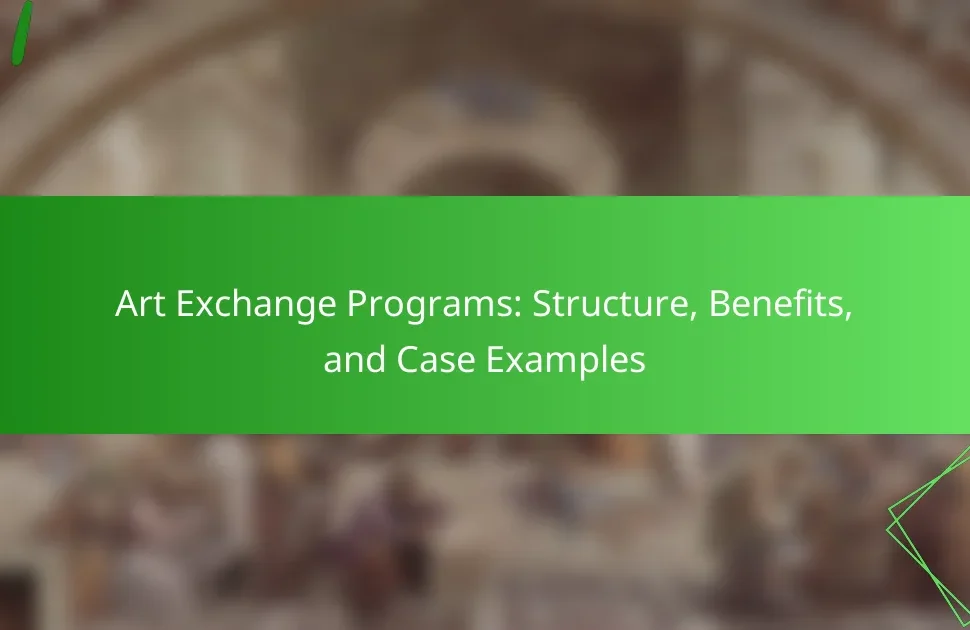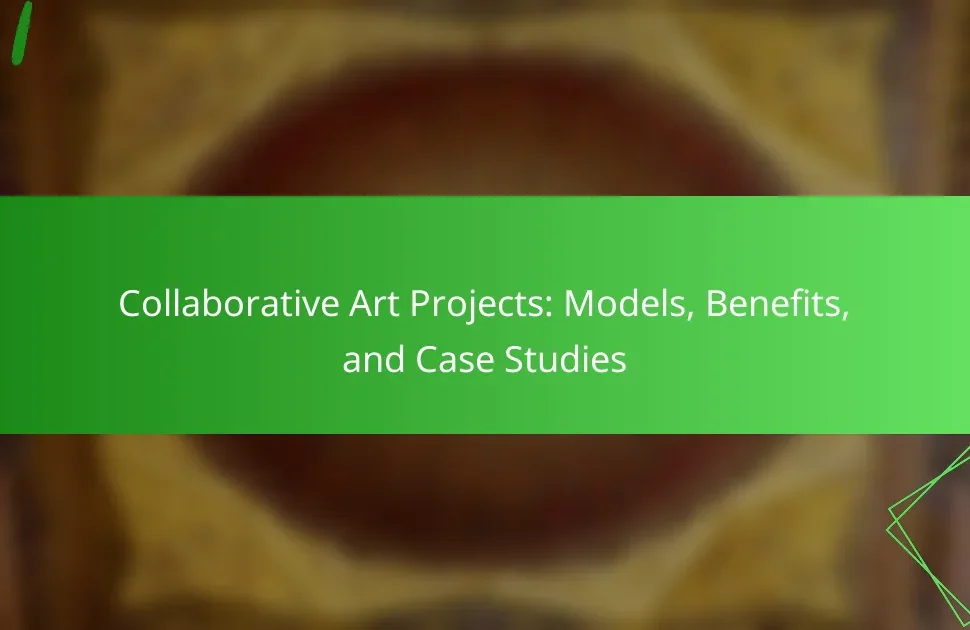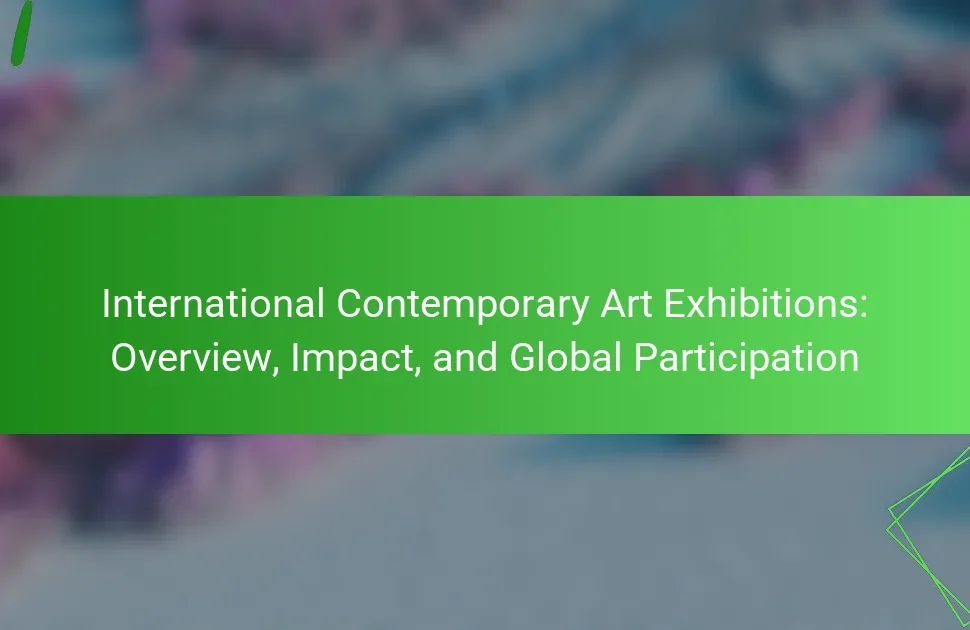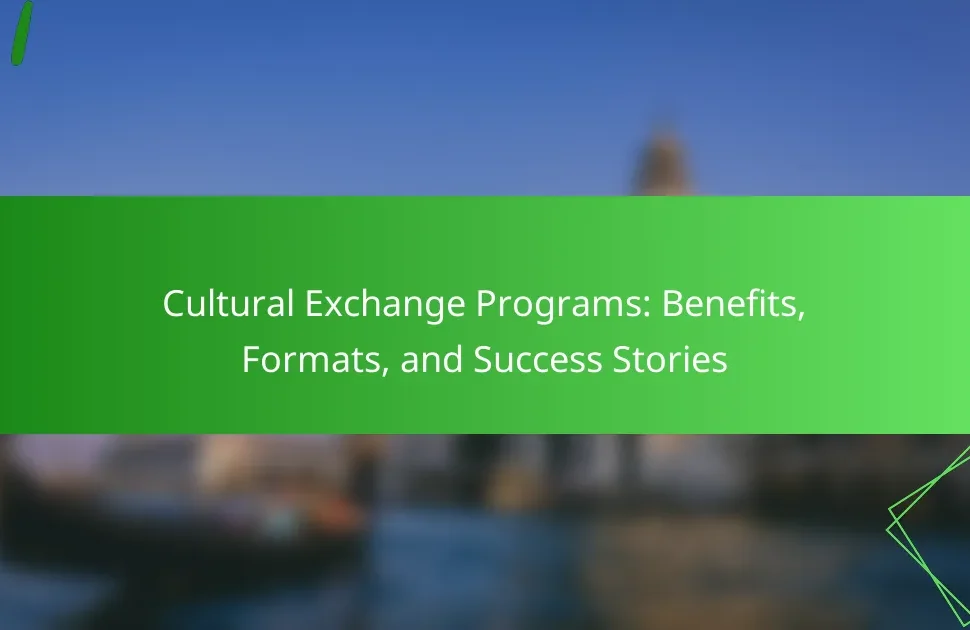Artist residencies offer vital opportunities for emerging artists, enhancing their growth and networking potential. These programs provide access to resources, mentorship, and collaborative experiences. They also foster cultural exchange and community engagement, stimulating local economies and promoting social inclusion. Understanding the diverse types of residencies and the challenges artists face can help navigate this enriching landscape.
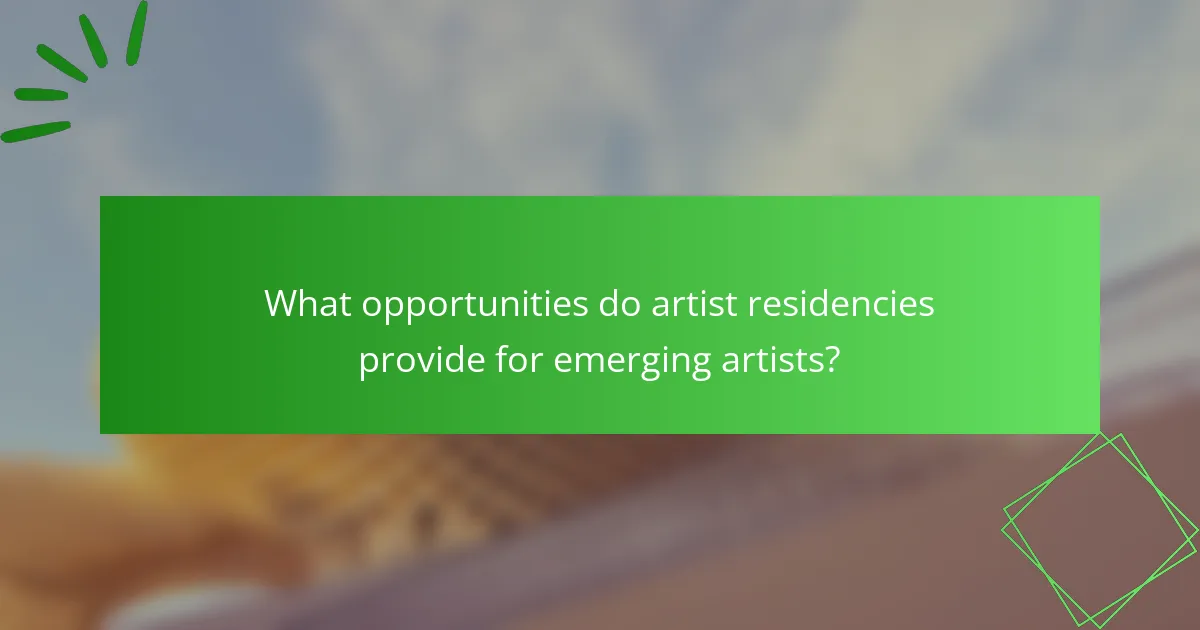
What opportunities do artist residencies provide for emerging artists?
Artist residencies provide emerging artists with vital opportunities for growth, networking, and exposure. They facilitate skill development through mentorship and workshops, allowing artists to refine their craft. Additionally, these residencies often offer access to resources, such as studio space and materials, which can significantly enhance creative output. Collaborations with other artists and participation in exhibitions further increase visibility and potential career advancement.
How do artist residencies enhance creative development?
Artist residencies enhance creative development by providing artists with dedicated time, space, and resources to explore their work. These programs foster collaboration, mentorship, and exposure to new ideas, significantly enriching artistic practice.
Residencies often include workshops, critiques, and networking opportunities, which help artists refine their skills and expand their perspectives. For instance, artists can engage with diverse communities, gaining insights that influence their creative processes.
Moreover, residencies frequently culminate in exhibitions or presentations, allowing artists to share their work with broader audiences. This visibility can lead to further opportunities and collaborations, reinforcing the cultural impact of the residency experience.
Overall, artist residencies serve as vital catalysts for personal and professional growth, enabling artists to push boundaries and innovate within their fields.
What networking benefits do artists gain from residencies?
Artists gain valuable networking benefits from residencies, including connections with fellow creatives, industry professionals, and potential collaborators. These interactions foster opportunities for joint projects and exhibitions, enhancing visibility and career advancement. Residencies often provide access to mentorship, which can lead to long-term professional relationships. Additionally, artists can engage with diverse audiences, expanding their reach and influence in the art community.
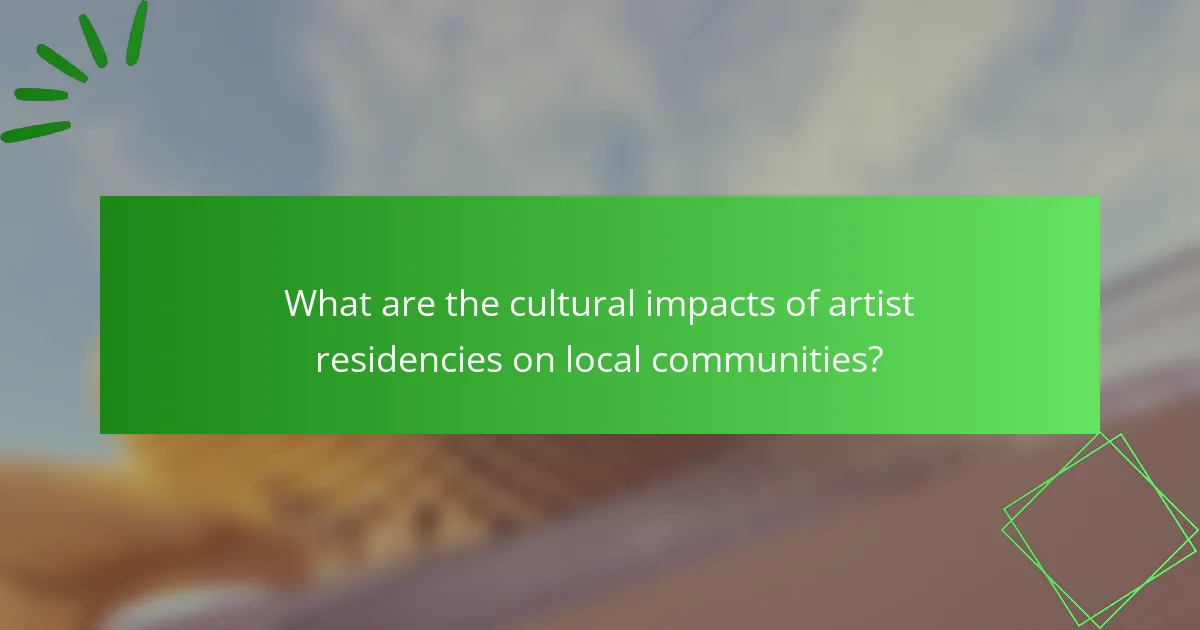
What are the cultural impacts of artist residencies on local communities?
Artist residencies significantly enhance local communities by fostering cultural exchange and creative collaboration. They provide artists with resources and support, allowing them to engage with local populations. This interaction often leads to community-driven projects that reflect local culture and history.
Moreover, residencies can stimulate local economies through increased tourism and local spending. Events and exhibitions organized by resident artists attract visitors, benefiting local businesses. In addition, artist residencies can promote social inclusion by giving underrepresented groups a platform to express their narratives and experiences.
The unique attribute of artist residencies is their ability to create lasting partnerships between artists and community organizations. These collaborations can lead to educational programs, workshops, and public art installations, enriching the cultural fabric of the area. As a result, artist residencies contribute to a vibrant, dynamic community identity.
How do artist residencies contribute to cultural exchange?
Artist residencies foster cultural exchange by connecting diverse artists and communities. They create platforms for collaboration, allowing participants to share techniques and perspectives. This interaction enhances creativity and promotes understanding between different cultures. For instance, many residencies offer workshops that encourage dialogue and artistic experimentation. Through these experiences, residencies contribute significantly to the global art landscape, enriching both individual artists and the communities they engage with.
What role do artist residencies play in community engagement?
Artist residencies enhance community engagement by fostering collaboration between artists and local residents. These programs create opportunities for cultural exchange, skill-building, and shared experiences. They often result in public art projects that reflect community identity and values. Additionally, residencies can stimulate local economies by attracting visitors and supporting local businesses.
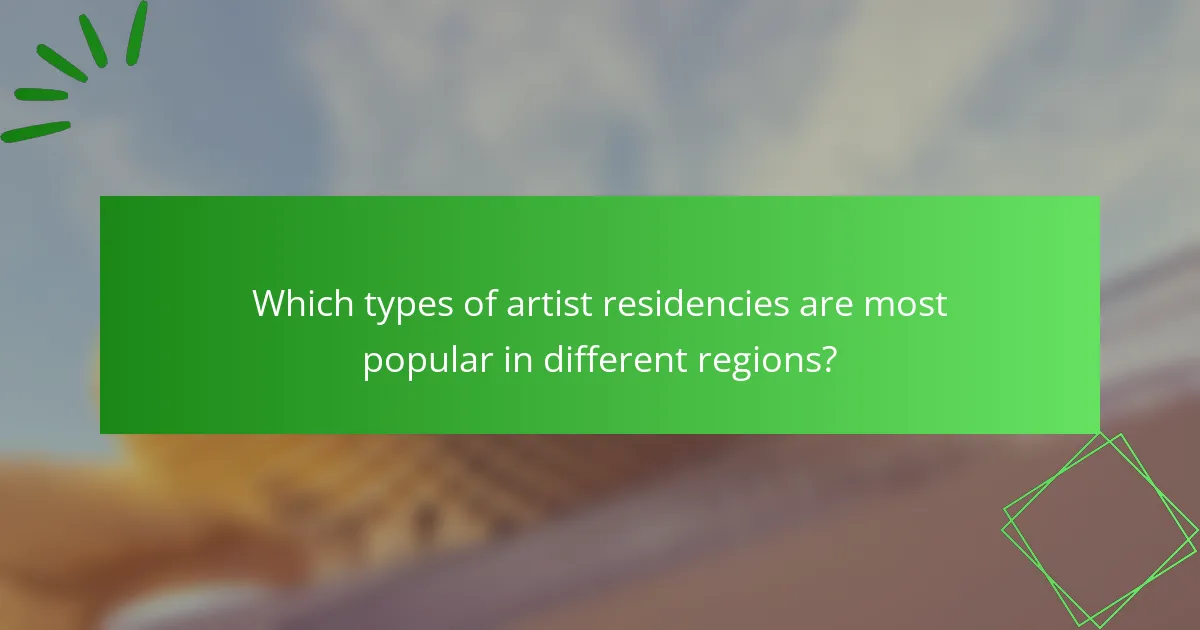
Which types of artist residencies are most popular in different regions?
Artist residencies vary significantly across regions, with specific types gaining popularity based on local culture and artistic needs. In North America, studio-based residencies are prevalent, offering artists dedicated workspace and time to create. Europe favors collaborative residencies that emphasize community engagement and interdisciplinary practices. In Asia, traditional art forms are often supported through residencies focused on cultural preservation and innovation. Australia promotes environmental art residencies, encouraging artists to engage with nature. Each type addresses unique regional artistic priorities and fosters cultural exchange.
What are the distinguishing features of urban versus rural residencies?
Urban residencies often provide access to vibrant cultural scenes and networking opportunities, while rural residencies emphasize tranquility and natural inspiration. Urban settings typically feature collaborative spaces and diverse artistic communities, whereas rural locations offer solitude and a focused environment. Urban residencies may have higher costs due to city living, whereas rural options often present more affordable accommodations. Each setting attracts different types of artists based on their creative needs and lifestyle preferences.
How do residency formats differ across cultural contexts?
Artist residencies vary significantly across cultural contexts, influencing opportunities and benefits. In Western countries, residencies often emphasize individual artistic development and networking. In contrast, many Asian residencies focus on community engagement and cultural exchange.
Residencies in Europe may provide substantial funding and institutional support, while those in Africa may prioritize local cultural narratives and sustainability. Unique attributes like duration and forms of intake also differ, with some programs offering short-term projects and others long-term commitments.
Cultural impact is profound; residencies can foster cross-cultural dialogue and enhance local art scenes. These differences shape the experiences and outcomes for artists, highlighting the importance of context in residency formats.
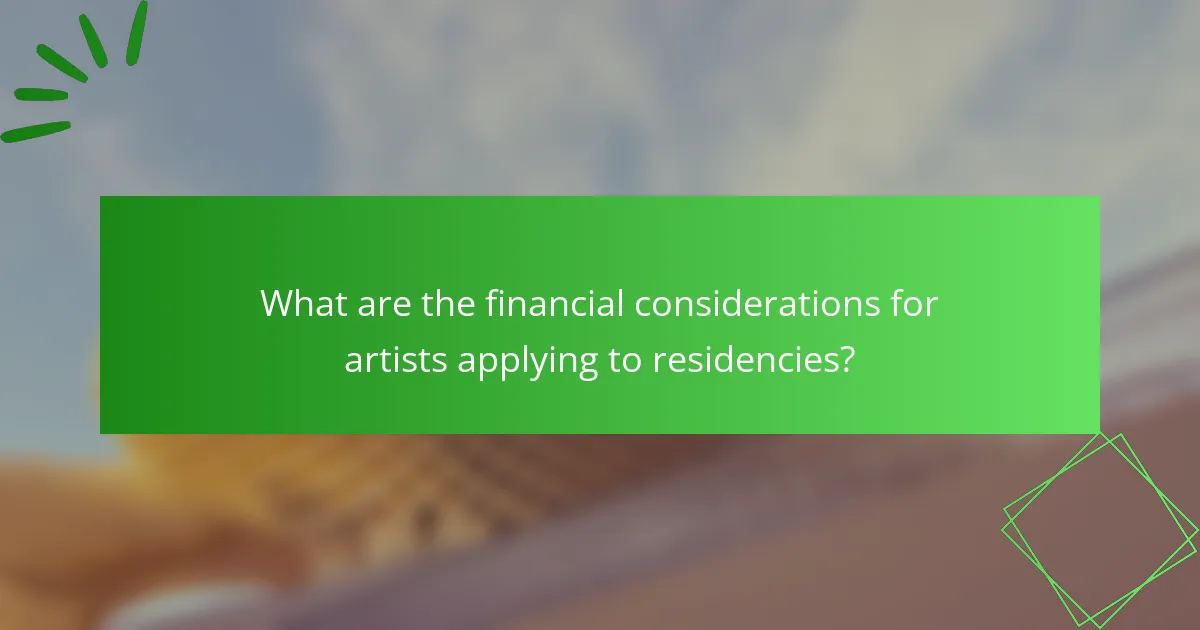
What are the financial considerations for artists applying to residencies?
Artists applying to residencies should consider funding sources, application fees, and living expenses. Many residencies offer stipends or grants, which can offset costs. Understanding the financial implications helps artists make informed decisions. Budgeting for travel and materials is crucial, as these costs can vary significantly. Additionally, some residencies provide housing, which can be a substantial financial benefit.
How do funding models vary among artist residencies?
Funding models for artist residencies vary significantly based on their objectives and resources. Common models include government grants, private sponsorship, and self-funding initiatives.
Government-funded residencies often prioritize cultural enrichment, providing artists with stipends and materials. Private sponsorships usually focus on brand alignment, offering financial support in exchange for visibility. Self-funded residencies require artists to cover their costs, which can limit opportunities but foster independence.
Each model influences the residency’s structure, duration, and accessibility. For example, government-funded programs may offer longer stays compared to privately sponsored ones, which can be shorter and more competitive.
What costs should artists anticipate during their residency?
Artists should anticipate several costs during their residency, including housing, materials, travel, and living expenses. Housing costs vary by location and can range from free accommodations to several hundred dollars per month. Materials may include art supplies, studio rental fees, and equipment, which can accumulate significantly. Travel expenses depend on the residency’s location and the artist’s home base, potentially adding to the overall budget. Living expenses, such as food and utilities, should also be factored in, as they can vary widely based on the residency’s duration and location.
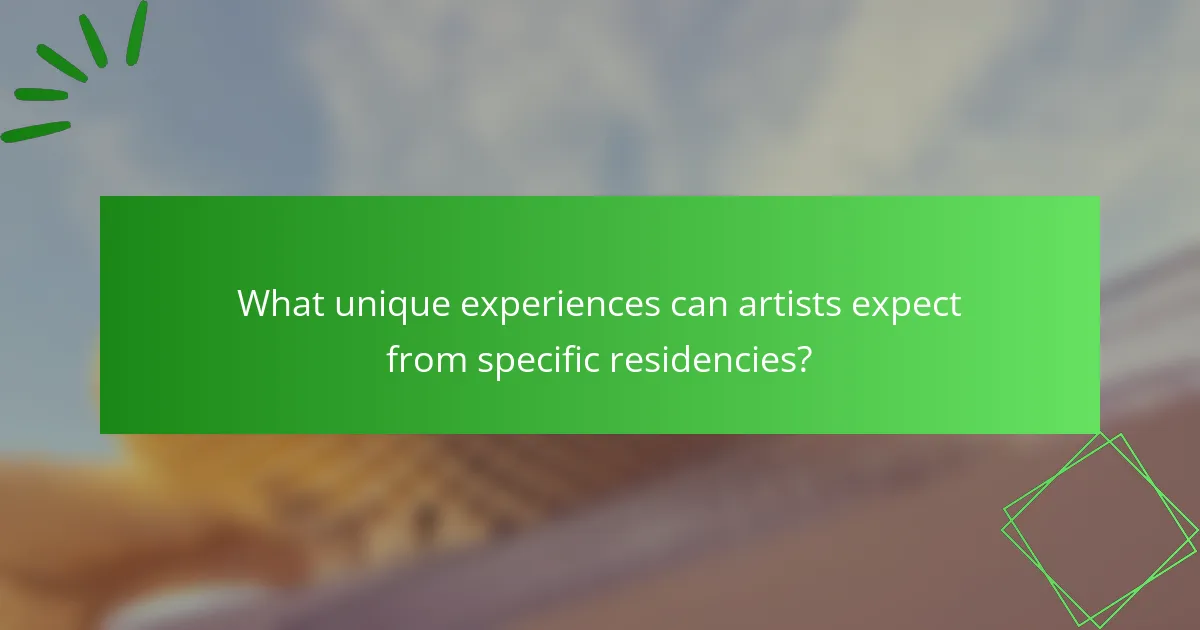
What unique experiences can artists expect from specific residencies?
Artists can expect diverse and transformative experiences from specific residencies. These programs often provide unique environments that foster creativity and collaboration.
For example, some residencies focus on cultural immersion, allowing artists to engage with local communities and traditions. Others emphasize interdisciplinary collaboration, connecting artists with professionals from various fields.
Many residencies offer dedicated studio space and access to resources like workshops and mentorship, enhancing artistic development. Additionally, the opportunity for public presentations can elevate an artist’s profile and facilitate networking.
Overall, the unique experiences vary widely, shaped by the residency’s goals and location, providing artists with invaluable opportunities for growth and exploration.
How do themed residencies enhance artistic exploration?
Themed residencies significantly enhance artistic exploration by providing focused environments that inspire creativity. These residencies often center around specific themes, allowing artists to delve deeply into particular concepts or cultural narratives. This focused approach fosters collaboration among artists with similar interests, leading to innovative ideas and cross-disciplinary projects.
Additionally, themed residencies can offer unique resources, such as expert mentors or specialized materials, that enhance the artistic process. Artists often report increased motivation and productivity during these residencies, as the immersive experience encourages experimentation and risk-taking. The cultural impact of themed residencies is profound, as they often engage local communities and contribute to cultural dialogue through exhibitions and public programs.
What are the benefits of collaborative residencies?
Collaborative residencies offer artists enhanced networking opportunities, skill sharing, and diverse creative environments. These benefits foster innovation and cultural exchange, enriching both individual practices and community engagement. Artists often gain access to resources and mentorship that can elevate their work. Additionally, collaborative settings encourage interdisciplinary projects, broadening artistic perspectives and potential audiences.
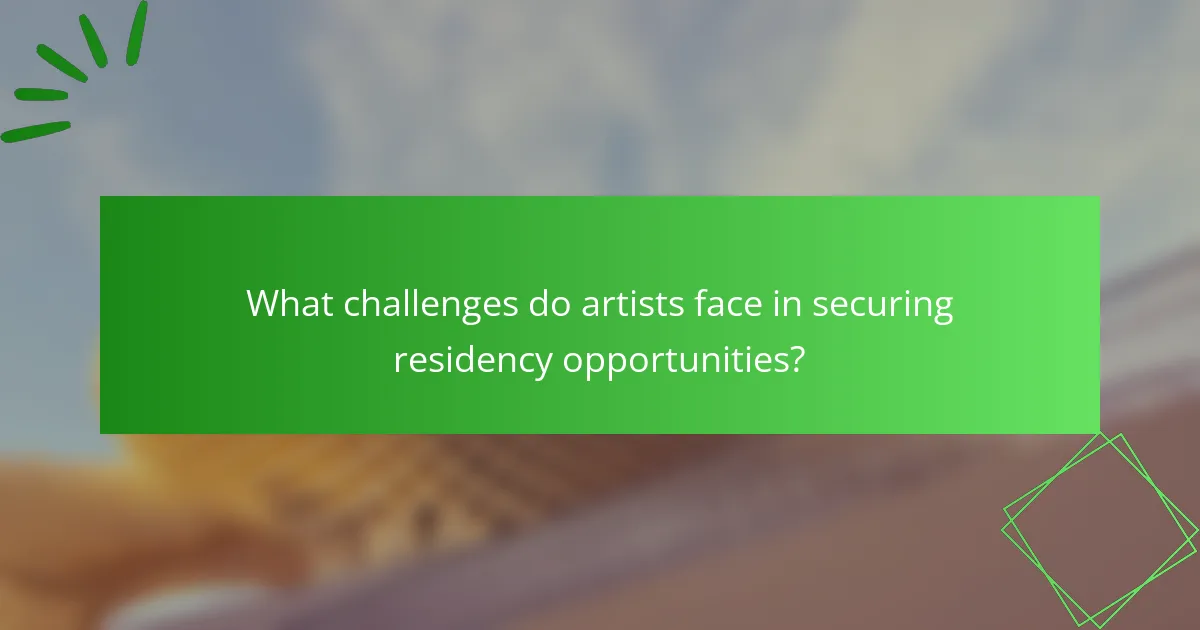
What challenges do artists face in securing residency opportunities?
Artists face significant challenges in securing residency opportunities, including competition, funding limitations, and application complexities. The high number of applicants often leads to intense competition, making it difficult for emerging artists to stand out. Additionally, many residencies require funding or sponsorship, which can restrict access for those without financial backing. The application process itself can be daunting, with detailed proposals and portfolios needed, which may deter some artists from applying. These factors collectively impact the diversity and representation within artist residency programs.
How can artists effectively navigate the application process?
Artists can effectively navigate the application process by thoroughly researching residency programs and tailoring each application to highlight relevant experiences. They should emphasize unique attributes of their work that align with the residency’s mission. Networking with previous residents can provide insights and tips. Additionally, maintaining a clear and professional presentation of their portfolio enhances their chances of selection.
What common pitfalls should artists avoid when applying?
Artists should avoid common pitfalls such as lack of research, unclear goals, and ignoring guidelines. Failing to tailor applications to specific residencies diminishes chances of acceptance. Additionally, overlooking deadlines and neglecting to showcase unique attributes can hinder success. Lastly, inadequate networking or not following up can limit future opportunities.
What strategies can enhance an artist’s residency application?
To enhance an artist’s residency application, focus on a strong portfolio, tailored proposals, and networking.
1. Develop a cohesive portfolio showcasing your best work relevant to the residency’s focus.
2. Craft a personalized proposal that aligns your artistic vision with the residency’s goals.
3. Highlight unique attributes of your practice, such as innovative techniques or themes.
4. Engage with previous residents or organizers to gain insights and strengthen connections.
5. Follow application guidelines meticulously to demonstrate professionalism and attention to detail.
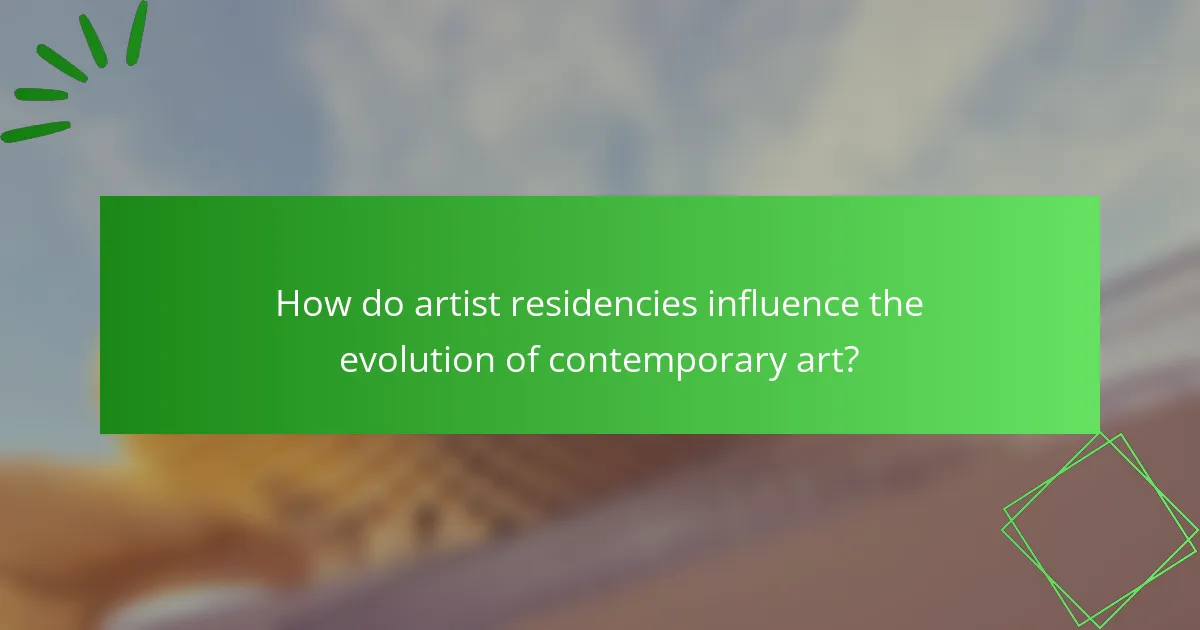
How do artist residencies influence the evolution of contemporary art?
Artist residencies significantly influence contemporary art by providing artists with dedicated time, space, and resources for creative exploration. These opportunities foster innovation and collaboration among diverse artists. Residencies often lead to the development of new techniques and concepts, enhancing artistic evolution. They also facilitate cultural exchange, allowing artists to engage with local communities, which enriches their work and broadens their perspectives. As a result, artist residencies play a crucial role in shaping the contemporary art landscape.
What are the long-term career impacts of participating in a residency?
Participating in a residency can significantly enhance an artist’s long-term career prospects. Residencies provide networking opportunities, access to mentorship, and exposure to diverse audiences. As a result, artists often experience increased visibility and potential for collaborations. Unique attributes of residencies, such as access to specialized resources, can lead to the development of a distinct artistic voice. Additionally, artists may secure future exhibition opportunities or funding as a direct outcome of their residency experiences.
How do residencies shape artistic trends and movements?
Artist residencies significantly influence artistic trends and movements by providing artists with dedicated time, space, and resources for exploration. These programs foster collaboration and innovation, leading to the emergence of new styles and concepts. Residencies often encourage interdisciplinary approaches, allowing artists to draw inspiration from diverse fields. They also facilitate community engagement, promoting cultural exchange and dialogue that shapes contemporary art. The unique environment of a residency can lead to the development of rare artistic practices that may not emerge in traditional studio settings.
What role do residencies play in fostering innovation in the arts?
Artist residencies play a crucial role in fostering innovation in the arts by providing artists with dedicated time and space to create. These programs often offer resources, mentorship, and exposure to new ideas, which can lead to the development of unique artistic practices.
Residencies encourage collaboration among artists, facilitating the exchange of diverse perspectives. This interaction often results in groundbreaking projects that challenge traditional art forms and explore contemporary issues. Additionally, residencies can enhance community engagement by connecting artists with local cultures and audiences, further enriching the artistic landscape.
Financial support is another key aspect of residencies. Many programs offer stipends or grants, allowing artists to focus solely on their work without financial burdens. This support can lead to significant advancements in an artist’s career, as they can experiment freely and push creative boundaries.
Overall, artist residencies serve as incubators for innovation, enabling artists to explore new concepts and contribute to the evolving narrative of contemporary art.
What best practices can maximize the benefits of an artist residency?
To maximize the benefits of an artist residency, engage actively with the community and utilize available resources. Building connections with other artists and local organizations enhances collaborative opportunities. Set clear goals for your residency, focusing on personal growth and project development. Regularly reflect on your progress to adapt your approach and maximize outcomes.
